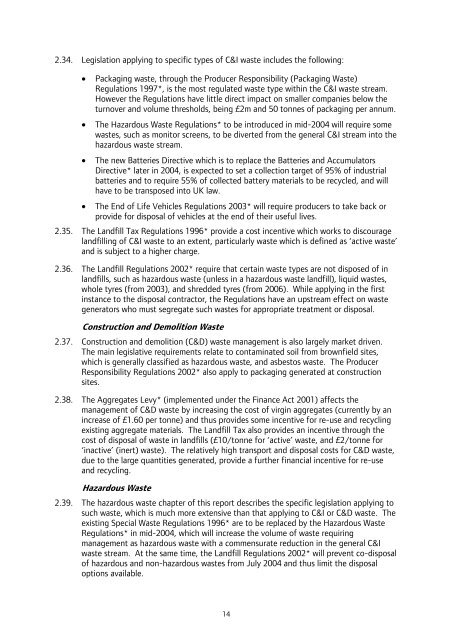London Wider Waste Strategy - London - Greater London Authority
London Wider Waste Strategy - London - Greater London Authority
London Wider Waste Strategy - London - Greater London Authority
Create successful ePaper yourself
Turn your PDF publications into a flip-book with our unique Google optimized e-Paper software.
2.34. Legislation applying to specific types of C&I waste includes the following:<br />
• Packaging waste, through the Producer Responsibility (Packaging <strong>Waste</strong>)<br />
Regulations 1997*, is the most regulated waste type within the C&I waste stream.<br />
However the Regulations have little direct impact on smaller companies below the<br />
turnover and volume thresholds, being £2m and 50 tonnes of packaging per annum.<br />
• The Hazardous <strong>Waste</strong> Regulations* to be introduced in mid-2004 will require some<br />
wastes, such as monitor screens, to be diverted from the general C&I stream into the<br />
hazardous waste stream.<br />
• The new Batteries Directive which is to replace the Batteries and Accumulators<br />
Directive* later in 2004, is expected to set a collection target of 95% of industrial<br />
batteries and to require 55% of collected battery materials to be recycled, and will<br />
have to be transposed into UK law.<br />
• The End of Life Vehicles Regulations 2003* will require producers to take back or<br />
provide for disposal of vehicles at the end of their useful lives.<br />
2.35. The Landfill Tax Regulations 1996* provide a cost incentive which works to discourage<br />
landfilling of C&I waste to an extent, particularly waste which is defined as ‘active waste’<br />
and is subject to a higher charge.<br />
2.36. The Landfill Regulations 2002* require that certain waste types are not disposed of in<br />
landfills, such as hazardous waste (unless in a hazardous waste landfill), liquid wastes,<br />
whole tyres (from 2003), and shredded tyres (from 2006). While applying in the first<br />
instance to the disposal contractor, the Regulations have an upstream effect on waste<br />
generators who must segregate such wastes for appropriate treatment or disposal.<br />
Construction and Demolition <strong>Waste</strong><br />
2.37. Construction and demolition (C&D) waste management is also largely market driven.<br />
The main legislative requirements relate to contaminated soil from brownfield sites,<br />
which is generally classified as hazardous waste, and asbestos waste. The Producer<br />
Responsibility Regulations 2002* also apply to packaging generated at construction<br />
sites.<br />
2.38. The Aggregates Levy* (implemented under the Finance Act 2001) affects the<br />
management of C&D waste by increasing the cost of virgin aggregates (currently by an<br />
increase of £1.60 per tonne) and thus provides some incentive for re-use and recycling<br />
existing aggregate materials. The Landfill Tax also provides an incentive through the<br />
cost of disposal of waste in landfills (£10/tonne for ‘active’ waste, and £2/tonne for<br />
‘inactive’ (inert) waste). The relatively high transport and disposal costs for C&D waste,<br />
due to the large quantities generated, provide a further financial incentive for re-use<br />
and recycling.<br />
Hazardous <strong>Waste</strong><br />
2.39. The hazardous waste chapter of this report describes the specific legislation applying to<br />
such waste, which is much more extensive than that applying to C&I or C&D waste. The<br />
existing Special <strong>Waste</strong> Regulations 1996* are to be replaced by the Hazardous <strong>Waste</strong><br />
Regulations* in mid-2004, which will increase the volume of waste requiring<br />
management as hazardous waste with a commensurate reduction in the general C&I<br />
waste stream. At the same time, the Landfill Regulations 2002* will prevent co-disposal<br />
of hazardous and non-hazardous wastes from July 2004 and thus limit the disposal<br />
options available.<br />
14
















